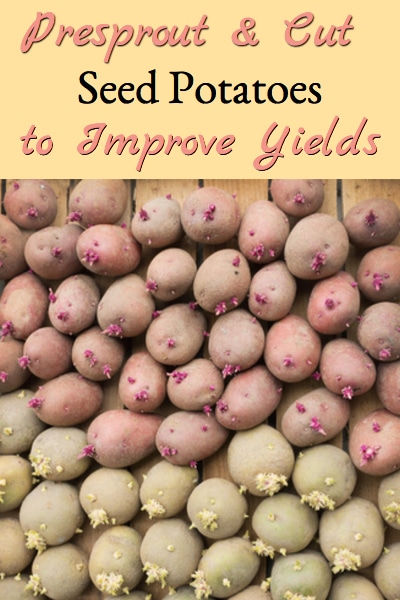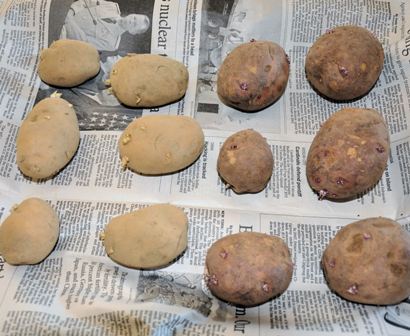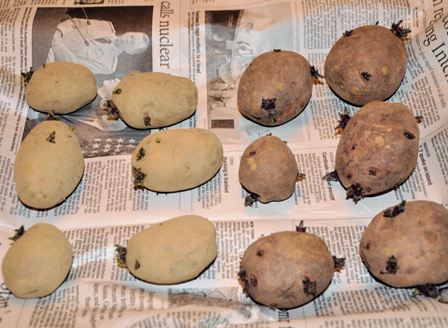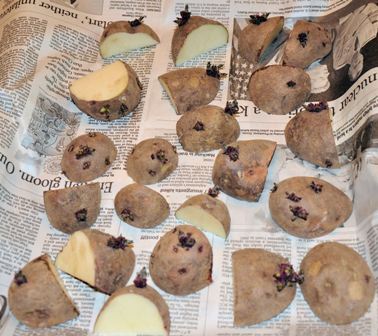
Potato Planting Preparations
I used to think that growing potatoes (see HERE for more potato background) in the garden was too much work for the end result. Then a friend’s homegrown Yukon Gold potatoes completely changed my mind. Like almost anything that’s homegrown, they just tasted so much better than potatoes from the grocery store.
That’s when we started growing our own potatoes and found that in addition to tasting much better than store-bought potatoes, they were really an easy crop to grow. And, that many varieties store well in the root cellar so we could have great tasting potatoes nearly year-round.
Now, we grow potatoes every year and our potato planting preparations include pre-sprouting (also known as greensprouting) & cutting seed potatoes. These practices encourage early growth, improve yields, and speed up the production of tubers.
Fast, early growth is beneficial when growing potatoes. If you can get them in, grow them quickly, and get them harvested fast there’s less chance that pests (see Controlling Potato Beetles) or bad weather will damage your crop of potatoes.
Pre-sprouting & cutting seed potatoes means a few extra steps but it takes just a little extra time and can significantly improve productivity.
How To Pre – Sprout Seed Potatoes
We purchase certified organic seed potatoes (for example the organic seed potatoes from Wood Prairie Farm) early in the season when there is a good selection of varieties. We store them in a cool (40 degrees) dark root cellar until about two weeks before I intend to plant them. Potatoes shouldn’t be planted until the soil temperature reaches 50°F. The varieties shown in the photos below are Yukon Gold and Purple Viking.
Then I spread them out on a tray in a room with medium light and 70-degree temperatures. The warmth promotes the development of strong sprouts. The light causes the sprouts to stay short and stubby (not weak or easily broken off). This step adds a little more work, but results in quicker tuber development and also heavier yields.

Unsprouted Seed Potatoes
The photo above shows the whole seed potatoes prior to pre-sprouting while the photo below shows them after pre-sprouting. Pre-sprouting or greensprouting can reduce the time to mature potatoes in the field by 10 – 14 days. We pre-sprout the entire potato crop since we have a fairly short growing season. We use every method we know to get the crop in and grown quickly.

Pre-sprouted Seed Potatoes
Even if you don’t pre-sprout your seed potatoes, simply warming the seed potatoes up before planting will be beneficial. Warming the seed potatoes at 70°F for 48 – 72 hours before planting will improve germination rate and yields too. Don’t plant cold potatoes!
Cutting Seed Potatoes
Small potatoes (the size of a small egg) can be planted whole, but larger potatoes should be cut into smaller pieces. The ideal potato seed is a 1 1/2-ounce block with two or more eyes/sprouts per seed. Therefore, larger seed potatoes should be cut into 2, 3, or 4 blocks per tuber.
After cutting, the seed pieces should be left at room temperature for at least twenty-four hours. This allows them to firm up and reduces the chance of rotting. To further minimize the chance of rot, the cut surfaces can be dusted with calcitic or dolomitic agricultural lime or sulfur. After twenty-four hours, I plant them using the “Lazy Bed Potato Planting Method”.

Seed Potatoes After Cutting
We’ve found that by using these methods for preparing the seed potatoes for planting, using the lazy bed method for growing the potatoes, and making sure that we ALWAYS rotate the potato crop (see Garden Crop Rotation – A Simple System) potatoes are a really easy and productive crop for us to grow each year.
Mark says
Hi. What’s the longest I can leave my cut seed potatoes out for? Do I need to plant them within a couple of days or if I waited a couple of weeks would they be okay?
Lisa says
I’ve got the same question too !
Howd you go?
Lesa says
Hi Mark,
If you’ve already pre-sprouted them, you really should plant within a couple of days for best results. If they haven’t been pre-sprouted than you can go ahead and wait for them to sprout which should take a couple of weeks.
john z. says
Can I use agricultural gypsum to “dust” my cut seed potatoes to reduce rot instead of: “the cut surfaces can be dusted with calcitic or dolomitic agricultural lime or sulfur.”
Lesa says
Yes John, I believe gypsum should work!
Rose Meintel says
My sprouts are growing on my potato seed and I still have two weeks before it is warm enough to plant them. Do I need to worry about the sprout being too big? Thank you, Rose
Lesa says
Hi Rose,
You can usually sprout potatoes for about 3 – 4 weeks before needing to plant them. If you’re worried about them getting too big, you can move them to a dark room and the sprout growth should slow.